(Originally written in December 2021)
Next week my daughter turns four, and so does one of the above kale plants.
It was in December 2017 that I sowed a handful of kale seeds. We ate leaves from the plants that grew through that winter while my daughter was learning to open her eyes and recognize her siblings. Some of the plants continued growing well through the spring and summer too. When they all turned one, I took this picture:
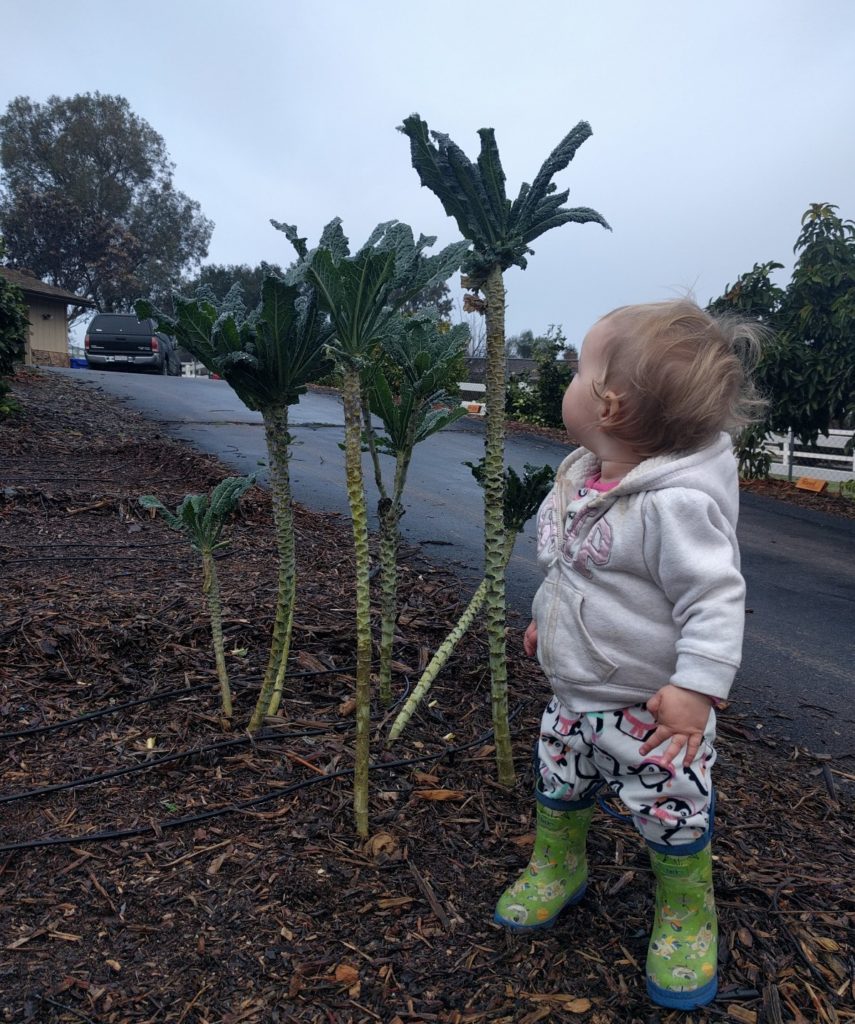
Then the kale plants succumbed to infestations of aphids or ended their lives naturally by blooming and making seed — except for one.
I started to think of this surviving kale plant as special since it was the same age as my daughter. Then a strong storm came through and blew it over. I thought it was a goner, but I staked it back up and it recovered. I took this photo of the two two-year olds:
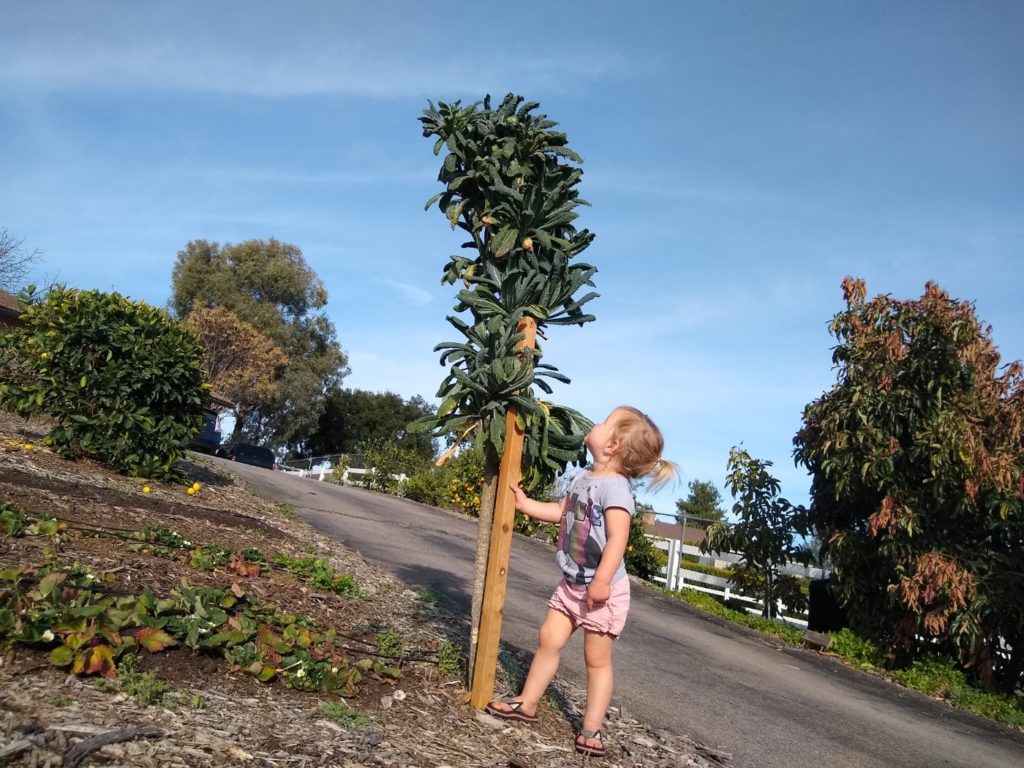
The plant is a type of kale often called “Dinosaur” kale because the bumpy leaves resemble the imagined skin of dinosaurs. But it also goes by many other names: Lacinato, Tuscan, Italian, or Black kale.
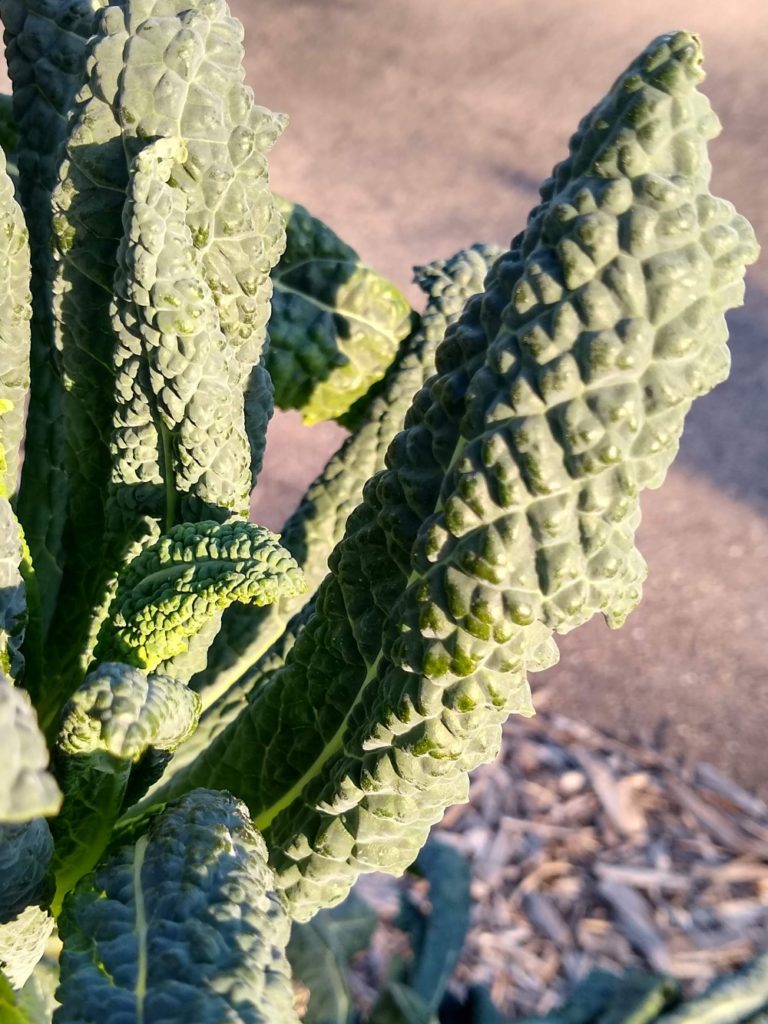
At some point every year, Reeve’s dinosaur kale plant harbors lots of aphids, but my style is to let nature take its course and so I allow predators like lady bugs and birds and parasitic wasps to eat or utilize them, and the seasonal aphids always eventually vanish.
Reeve could no longer reach any of the leaves on her kale plant last year, on her third birthday. The highest leaves reached seven feet tall.

And the plant keeps growing. Having been a fixture in the yard for four years now, I don’t always notice it anymore. Visitors point it out though.
“What is that?” they’ll ask.
“Oh yeah, that’s actually a kale plant. It’s many years old and just keeps growing, up and up and up.”
“Do you still eat it?”
“Sometimes, but most often I pick its leaves for our chickens.”
“But it’s edible?”
“Yeah, let’s pick some.”
Just last month I ate some of its raw leaves with some visitor friends. They were not as tender as baby kale, but not fibrous or bitter either.
Why is this one kale plant so tough? Why won’t it flower? How long will it live? How tall will it get?
Here in December of 2021 it is four years old and measures 96 inches. That’s eight feet tall!
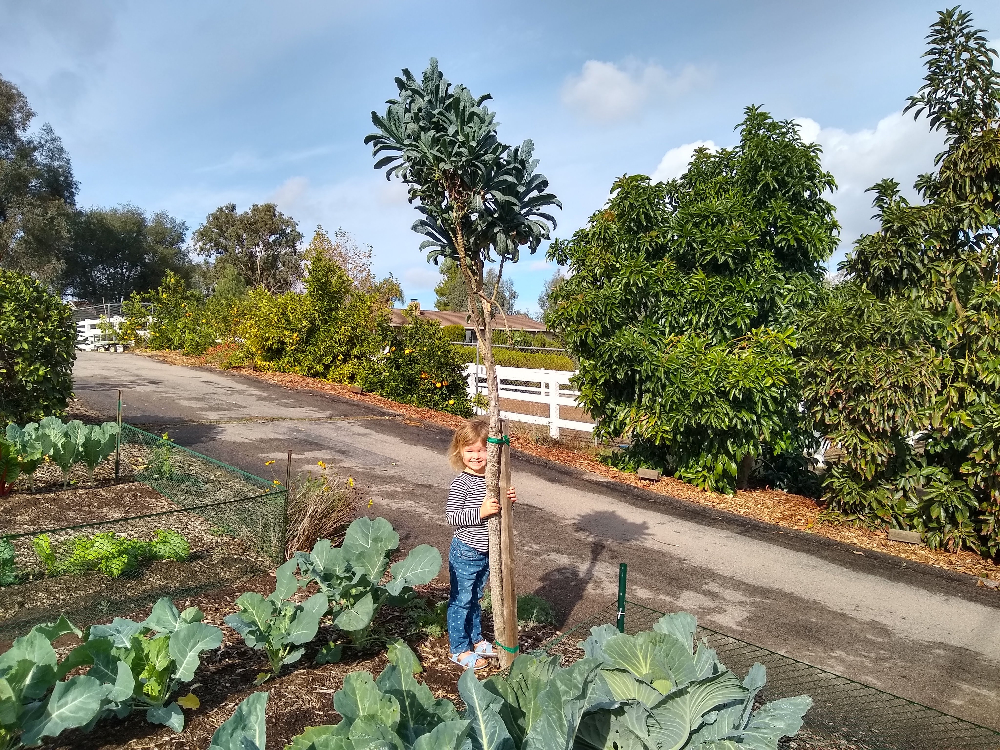
UPDATE:
All good things come to an end, and it was in the next summer that Reeve’s super-tall kale plant gave up life. This was my final photo of the plant before cutting it down in July, 2022:

Thanks for your support so I can keep these Yard Posts coming and ad-free.
All of my Yard Posts are listed HERE.

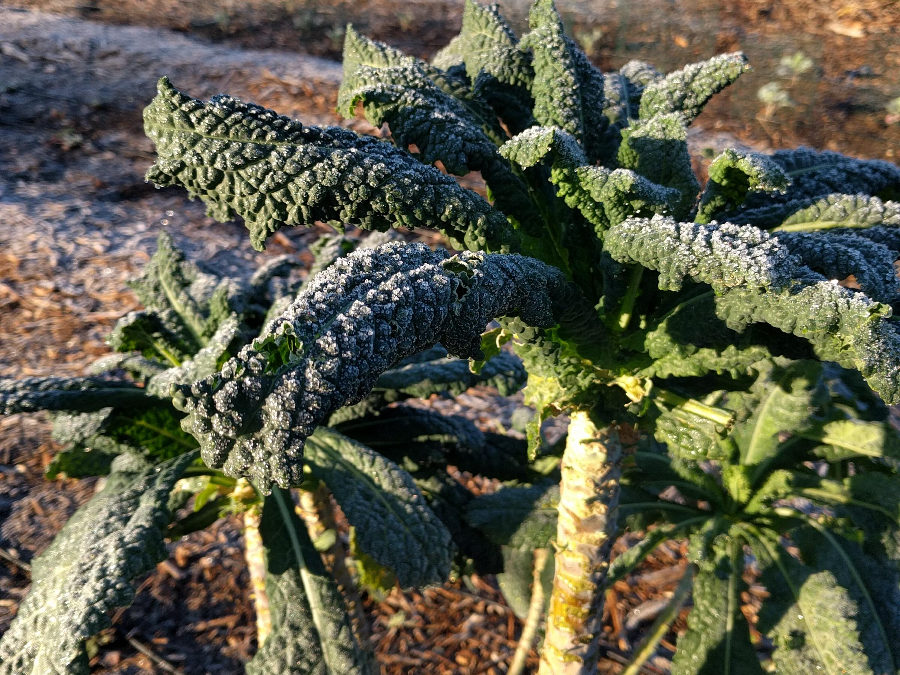


As a first time gardener who eats kale everyday, I planted 5 dinosaur kale seeds in autumn that are now 1.5 feet tall. Recently found out that it’ll continue to produce for 2 years and now this. It just keeps getting better !
Yes, Saud! The key will be to not give up on the plants if they start to look sad or get lots of aphids when the weather heats up. Trust that they’ll likely recover.
Greg,
I’m glad you have shown this to us. This a first timer i have ever heard about this type of kale. I grow the regular kind and i too have a problem with blue aphids collecting an masses on leaves especially in warm weather. I deal with them by removing the most infected leaves and water spray that knocks a lot down or pierces their soft bodies. i have lady bugs around especially on lettuce but don’t see any on kale, maybe the bluish aphids are not as tasty as the green ones for lady bugs.
Hi Paul,
That’s possible. Maybe ladybugs prefer certain aphids over others.
Parasitic wasps seem to do a lot of aphid control for us too. Have you ever noticed that some aphids are a tan color, and if you look closely there is a hole through them?
Comment *Hello
I live in Israel and am writing a book about plants that appear in the books of Judaism 1700 years ago. There it is written that a cabbage resembles a tree. Now I understand it better. Very happy if you could update what came out in the end with your kale. In the book I’m publishing I can publish the story of your kale with pictures. If you like it, I’d love to get in touch with you. I used google translate and I hope it is ok.
Thanks
Hi Eli,
I have updated the post to show how and when this kale story ended. Thanks for your interest.
Your cabbage leaves can create a lot of interest in the Land of Israel among students. I would love to write about him in my book. Attach photos, and of course give you full credit. I would be very happy if you would agree to this and send me quality photos of him at all stages. Thank you
Hi Greg,
I know you are coming to the Lake San Marcos Garden Club to speak and I don’t know if you settled on a topic with Roz, but as I was reading your Blog this time I thought a topic could be “How to Grow a Great Salad” – could be fun. Just a thought.
I am still really enjoying your Blog – thank you!
Chris Elliott
Hi Chris,
I love that idea. I’ll talk to Roz about it; we haven’t settled on a topic yet. Thanks!
Thanks for the headsup on the GEMs. I almost went! But as mentioned in a past post when I bot a Sharwil and Ettinger, I pulled out two baby Fuertes and grafted one to a Reed and the other to Pinkerton. It looks like the grafts are taking, plan leaving Fuerte limbs on both, so will have 13 varieties, diminishing the need for GEM. Thanks again for all the insightful information.
Frank, I like that idea of leaving lower limbs as Fuerte. That should work well since Fuerte branches usually don’t grow very upright anyway.
Hi Gregg
Just found your posts and want to thank you for the reliable information.
I very much enjoy your writing style and look forward to future posts.
Linda
Hi Linda,
Thanks for taking the time to write that. Appreciate it!
Kale is a new plant for me. Can you tell me if I can grow at an altitude of 4500 ft , to be specific Kathmandu, Nepal. If so where can I get this plant, please let me know.
Thank you and Happy Birthday to your daughter.
Hi Benu,
Great to hear from you. Thank you! I am pretty sure you can grow kale in Kathmandu. I first grew kale in southern Africa where I lived at an altitude of about 5,000 feet (29 degrees latitude); and I recently visited family here in the U.S. where their garden is at an altitude of about 4,500 feet (Reno, Nevada; 39 degrees latitude) and they had some nice kale growing.
As for where to get seeds or plants, I have no idea. Sorry. But as you search, do know that kale might go by other names in your area. When I lived in southern Africa, for example, they didn’t call it kale. They had a different local name for it. To complicate matters, the botanical name is Brassica oleracea; but that species name covers diverse plants from broccoli to cabbage to Brussels sprouts to cauliflower to collards.
Anyway, it might be helpful to see some examples of different types of kale here at Johnny’s: https://www.johnnyseeds.com/search/?q=kale&lang=en_US
Thank you Greg for your prompt response.
I can’t grow kale long term. Kale I’ve grown past winter, gets covered with aphids and ants. It seriously creeps me out. I’ve jetted them off with water, only to have them come back with a vengeance. AAACCK! On a more pleasant note…. I got your calendar! I’m already using its tips for Dec. So happy to get advice for us So.Cal veggie gardens. 🙂
Hi Lyn,
My kale plants get lots of aphids at times too. And sometimes I also want to say, Aaaaack! I either stop harvesting them for a while or I jet them off with water immediately before harvest — but like you said, the aphids usually re-colonize the leaves within a day or two.
If you have the garden space, and a kale plant seems otherwise healthy, try one time letting it live despite being infested with aphids. Whenever I’ve done this, I’ve found that eventually the number of aphids declines and sometimes totally disappears for a season. If you have a hand lens or another way of magnifying, then you can also see that many of the aphids will have a hole in them because they’ve been parasitized. It’s neat to watch the cycles of and relationships between bugs out there.
Hope you enjoy the calendar!
I’m here to do my seasonal spamming, I can’t believe this is the last article I looked at. Got 3 Dino Kale that I started last summer and they’re around 4′ tall. Got attacked my aphids big time but the ladybugs came in and sorted them out. I got my seeds from a Youtube grower who has been crossing the dino kale with his tree collards. The leaves are flat and smooth and very tender. I like to cook them up like collared greens with hamhocks or I throw them in soups and recently I stir fried some garlic chicken wings and I chopped up the kale and threw it in and they were deLISH… I learned to cut out the tubular fibrous stalk they are too tough and just keep the green stuff to cook. Do a search on Youtube for Plant Abudance I believe is the channel and his Dino Tree Kale, it’s unlike any other that I’ve seen in pictures that I suppose would be the traditional Dino Kale.
My toscano kale is going on 8 feet. It has tiers of kale. Very awesome.
I have a lacinata kale, aka dinosaur kale, that I planted late August of 2020, and it is still growing strong. I love that I can go harvest some leaves for a kale and quinoa salad or tossing into a zuppa toscana. It did lay down with some snow we had at Christmas, and I’ve left it there. Perhaps I should have staked it like you! I live in Eugene Oregon, moderate climate, and need to plant some more, just in case the behemoth falls to it’s demise. I don’t get anywhere near the aphids like my standard crinkly leaved kale gets, maybe that one has too many hidey holes for the aphids.
Very interesting and timely, Jeannine. My cousin who lives in Tigard, Oregon was just visiting and we were talking about this kale plant of mine and wondering if there were any reason such a plant wouldn’t grow just as tall and old in his yard.
Hi, Greg,
I wish you or your readers would try this aphid remedy because it works so well with all my brassicas and is so easy: I give all my brassicas a worm-tea drink every week. It also prevents/kills/who cares the cabbage worms laid by the cabbage butterflies.
I keep a 5 gallon bucket of water by the hose and pour my worm castings in there whenever they are available. When the water is close to clear-colored, I know it’s time for more castings, or to stir the bucket.
It was explained to me that earthworm castings contain a concentration of an element that dissolves anything they ingest as they feed and that this element is taken up by the plant and dissolves the aphid or worm that ingests the plant. They just aren’t there anymore.
Hope this works for others, too.
Thanks for your excellent site.
Hello Greg, I only learned of your site today while I was exploring to learn of people’s experiences growing lacinato kale that have become long lived perennial plants . I lost my first composition and am starting over.This one will be more brief,I am sure…..?
Your tall long lived Tuscan kale plant certainly is a candidate for cloning by rooting cuttings …… have you done that yet ? I hope that the plant is still alive .
Some perennial kales and collards can and do bloom yet remain long lived perennial plants . It becomes an interesting question that if one of these years your plant does flower and seed …….. will it then decline and die or otherwise . Continually trimming off the flowers has helped some types to stay alive .
It is now known that climate can be a
determining factor in the blooming habits of perennial collards .A particular variety that never flowers in a mild climate may regularly flower in another harsher climate .
I shared Perennial tree collard cuttings with someone in a different climate than my southern CA climate and have come to understand this.
Your plant might /would be valuable to other SoCal gardeners , I suspect .
I know that I would like to be able to acquire the clone !
While it might not be terribly difficult for me to find my own by planting a bunch of seeds and hoping for a similar outcome, none the less , you have an interesting plant .
It is not generally very difficult to root cuttings of kale and collards …… tall perennials can be managed by pruning to keep them in bounds,etc.
With any luck you may be able to have many copies of your perennial Tuscan kale plant .
The idea is that when planting seed of lancinato kale there may be some genetic individuality from seedling to seedling that could be involved with the way a given plant will grow , along with the environmental factors .
I did learn how to send perennial tree collard cuttings to another CA county about a year and a half ago and be within the safety guidelines .
( legal ) I contacted Los Angeles County …… spoke to an inspector . etc…… used US mail.
It has been interesting to learn of your experiences with kale . I am happy to share what I know on the subject especially if there is an aspect that has not yet occurred to you and that can be helpful . I don’t know how familiar you are some of the concepts and ideas but just in case I have added something of value …… well that might be a good thing .
It would be interesting to here the latest developments !
I have Lacinato Kale aka Nerio di Toscana Kale, that have been growing for 3 years now in Houston. These plants have suffered through high temperatures and droughts and so far they have not bloomed. The seeds came from rareseeds.com. I’ve never had any visible issues with aphids although now and then I do see bug holes in some of the older lower leaves. As I harvest leaves I get shoots that come off of the bare stalk. I’ve been pulling these shoots off and rooting them in water to give to friends and family.
Hi Scott,
Thanks for sharing this. I’ve never thought of rooting the side shoots; I might try that.
I’m considering attempting to grow lacinato kale. In a container. On a second floor W facing balcony. In Las Vegas.
I’m interested in your thought/opinions/suggestions. And if it’s a waste of my time, I’d want to hear that too.
All the est,
Erin
Hi Erin,
I think that could work fine. As the plant(s) get bigger, just make sure to transfer them into bigger pots. I imagine the ultimate pot could be 5-gallon size but might need to be bigger.